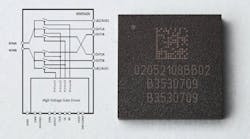With the launch of its MM5600 DPDT differential switch, Menlo Micro claims the industry’s highest performance and data rates for high-speed differential switching applications. Based on the company’s Ideal Switch technology, the MM5600 offers high-speed operation from DC to 20 GHz or 40 Gb/s, significantly outperforming conventional electromechanical (EM) relays and solid-state switches. The MM5600 switch’s flexible configuration also enables internal differential crossover capabilities, greatly simplifying board routing.
The MM5600 provides a high-performance differential switching device for high-speed digital applications based on the latest PCI Express standard, PCIe Gen 5, which doubles interconnect speeds over the PCIe 4.0 specification (32 GT/s vs. 16 GT/s). Faster PCIe speeds are essential for next-generation artificial intelligence (AI), machine learning (ML), 5G infrastructure, data center and cloud-based applications, as well as automated-test-equipment (ATE) device interface boards and high-speed computer peripheral interfaces. The MM5600 switch also can be configured for single-ended operation for RF and microwave applications.
Among the highlights of the MM5600 is its ultra-fast switching, with <10-µs operation time and <2-µs release time, said to be 1000x faster than EM relays, enabling reduced test time and cost-to-test. Additionally, the switch is rated for more than 3 billion switching cycles, which is also a 1000x improvement over the lifetime of EM relays.
The MM5600’s small-footprint/low-profile 64 mm2 design in an 8-mm x 8-mm x 1.6-mm QFN package provides a 90% size reduction compared to EM relays. The device also operates at less than 0.08 mW, a 99% reduction in power consumption compared to EM relays.
An integrated driver offers two modes of operation and can be controlled through a serial or parallel interface to drive the switch’s high-voltage gate lines. Full electrostatic-discharge (ESD) protection is included on all I/O ports.
Finally, the MM5600 achieves an IP3 linearity of more than +90 dBm with a power-handling capability of +33 dBm, enabling large reductions in distortion and delivering up to a 10,000x improvement over existing EM relays and solid-state switches. IP3 is the figure of merit in determining how much distortion a switch will introduce into a system, impacting the quality of transmitted or received signals.
Samples of the MM5600 DPDT differential switch are currently available.
